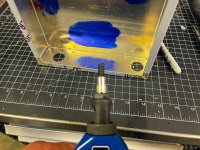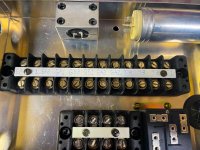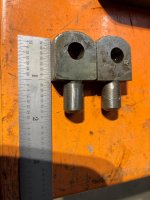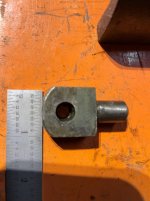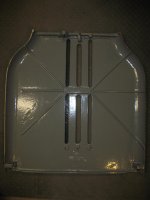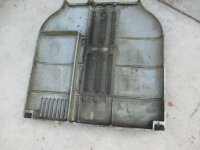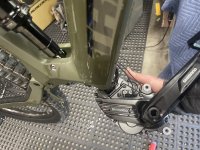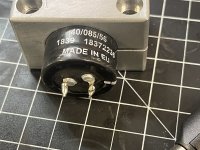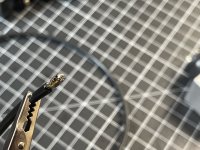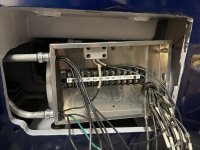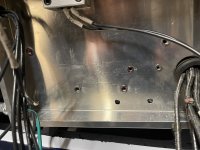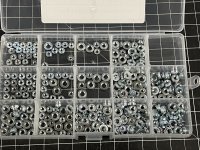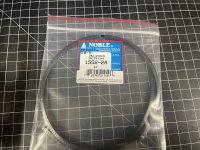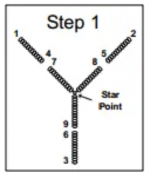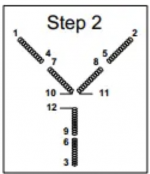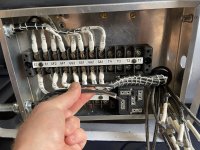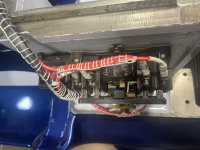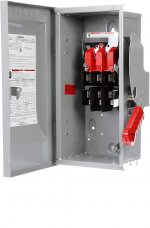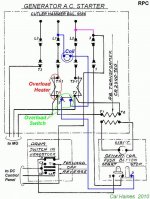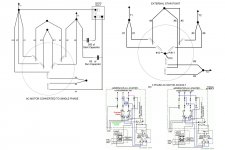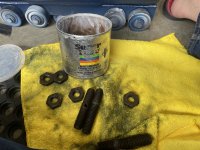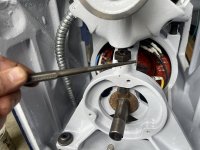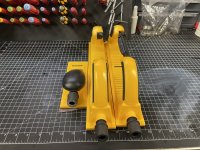I then connected the T1, T2, T3 leads and laced them. T3 is there incase I ever decide to convert back to the factory 3Phase system.

Ok, we are finally starting to get somewhere, and then I ran out of the solder filled crimps I have been using, so there it sat for a few days while I waited for order from McMaster. This is when I also realized my location for the Supco really won't work here.

Its going to have to lay horizontal on the bottom of the box to the left of the lower terminal block. That will give me more room for the wires.
When the rest of the crimps arrived from McMaster, I completed the connections for the Motor portion of the M/G.
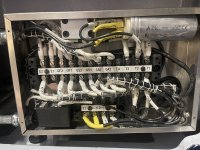
I used this schematic to make the connections.

Ok finally, I am starting to get close to being able to power up and test the M/G to see if this will actually work!
But first time for some math.
The ampere reading on the input side (L1 & L2) of the H-A-S Static Converter will read as expected with any single phase equipment. That is, as the load increases, amperage will increase and both lines will be carrying the same amount of amperage. It is important to remember that
these two lines will be carrying more amperage than the nameplate of a three phase motor will indicate. This is true because it will be carrying the same total power on two lines that it would be carrying on three lines when operating on three phase. The current required from single phase lines times 1.73 delivers the same power as three phase provided that the system efficiency and power factors are the same. For an H-A-S Static Converter-motor combination, the exact full load amperage taken from the single phase lines is calculated as follows:
(ConvertedMotorFLA=1.73PFH−A−S∗PF3Phase∗Eff3PhaseEffH−A−S∗FLA3Phase)
Where:
- PFH−A−S= Power Factor of H-A-S Static Converter and motor combination
- PF3Phase= Power Factor of H-A-S Static Converter and motor combination
- Eff3Phase= Efficiency of three phase motor from nameplate or motor data
- EffH−A−S= Efficiency of H-A-S Static Converter and motor combination
- FLA3Phase= Three phase full load amps from motor nameplate
At full load conditions, it has been found that the power factor of the H-A-S Static Converter – motor combination is approximately .95 and its efficiency to be very nearly the same as when the motor is operated on three phase. The ratio of Eff3Phase/EffH-A-S then becomes unity and our equation simplifies as follows:
(ConvertedMotorFLA=1.73 /.95∗PF3Phase∗FLA3Phase=1.82∗PF3Phase∗FLA3Phase)
FLA3Phase for this motor is 13.2A
ConvertedMotorFLA=(1.73 /.95) x PF3Phase x 13.2
ConvertedMotorFLA= 1.82 x .95 x 13.2
ConvertedMotorFLA = 22.8 Amps!
The above relationship should be used to determine maximum L1 and L2 heater coil and fuse sizing.
At first thought, it would appear that this amperage is excessive; but it must be remembered that due to the winding connections, the I2R losses are spread out over all the motor windings.
Evidently, The T3 amperage may read higher than T1 amperage at no load or partial loads. This condition is normal and will not damage the motor or the converter. The T3 amperage will decrease as the load on the motor increases, while T1 and T2 amperages will increase as the motor approaches full load conditions. Although the actual amperages for L1 and L2 may be easily calculated as shown above, the amperage to use for the proper heater coil sizing for T3 is not so easily obtained. For practical purposes, however, the maximum T3 amperages should be calculated as follows:
T3 = .75 x FLA
So T3 = .75 x 22.8
t3 = 17.11
So based upon that info, I looked up
the chart provided by Steelman and got the following:
Minium needed wire size for L1, L2, T1 is 10, for T2 it is 12 and for T3 it is 14. I used 10 for L1, L2 and T1 and then used 12 for T3.
So good to go there.
For the heater coil section the full load amperage is 22.8. I need to figure out what those Cutler Hammer #1375 heaters are actually rated at and confirm, they are adequate for this.
According to the Steelman chart, I should also add a heater to the T3 (starting circuit) with a value of 11.4 (thats a bit lower than the 17.11 I actually calculated) I will need to source one of these. I’ve never shopped for motor protection heaters before, so could really use some advice of what’s best to get for these. Seems like a big range on prices….
I'll need a 30 amp breaker for the mains.
The overall input wattage (I2R) of the motor at full load when operated with an H-A-S Static Converter does not exceed the overall input wattage of the motor when operated on three phase. For this reason, at full load conditions, the motor will have the same approximate temperature rise as if operated on three phase power.
